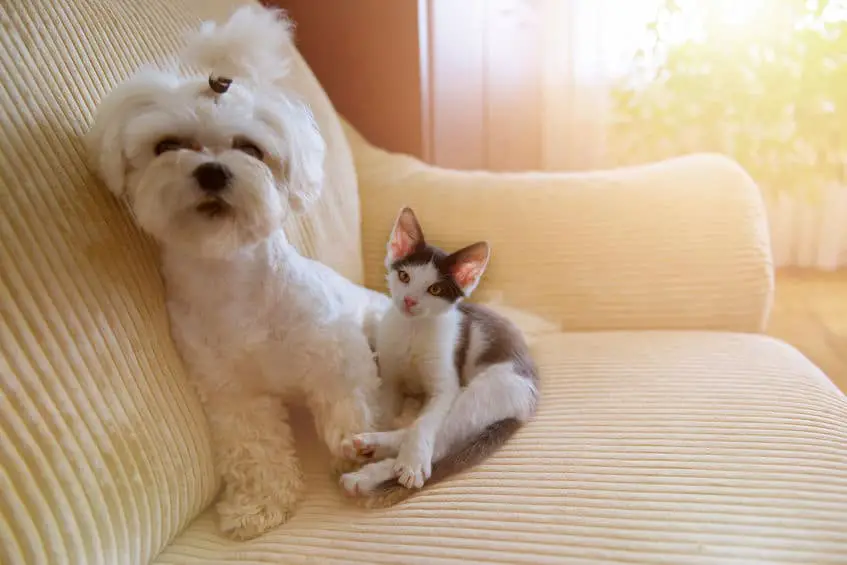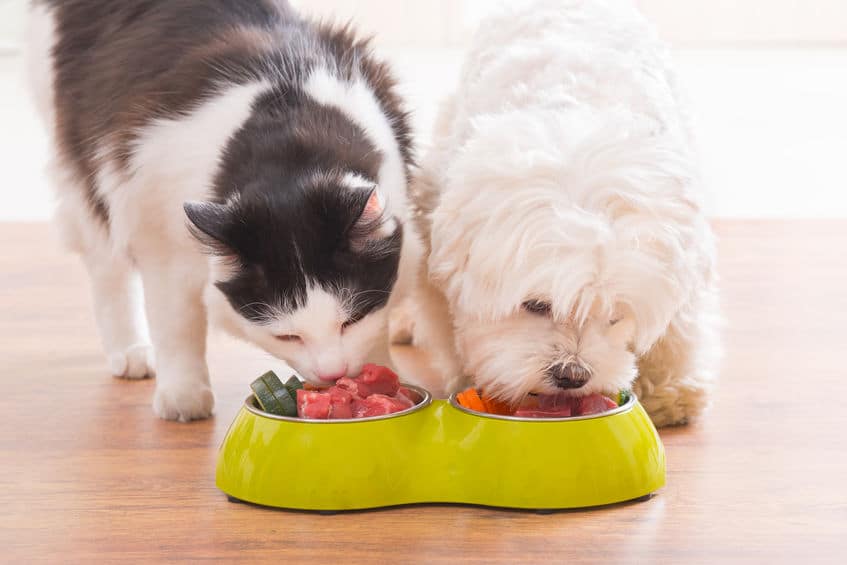It is common knowledge that wild dogs and cats aren’t some of the greatest pairs of animals to get along peacefully, but for domesticated dogs and cats, it becomes a different story.
Maltese dogs are known to be affectionate and friendly but do they get along with cats? Yes, a Maltese that has been properly socialized can get along with a cat, even become great friends with them.
The socialization of your Maltese is very important in the development of a stable, non-aggressive, and friendly dog.
This also applies to how they interact with other dogs and humans.
With that being said, in this blog post, I will be sharing the various methods to ensure there is a peaceful first-time introduction of both animals, as well as things to do and put in place to ensure a peaceful coexist.
First, let’s take a look at the personalities of the Maltese and that of the cat as well to help us get a better understanding of both.
The Maltese’s Personality
It is important to understand that every individual dog possesses its own unique personality, which is largely due to his/her training, socialization, environment, amongst other factors.
With that being said, in this section, I will be looking into the generally known and studied personality traits of the Maltese dog.
The Maltese is a charming, affectionate toy dog breed that is known to have been around for a long time, even getting a cameo mention in the bible.
Originating from the Mediterranean city of Malta, hence their name, their gentle and playful nature makes them amazing companion and lap dog.
Regardless of their nature and appearance, the Maltese dog is also a hardy, outgoing, and adaptable toy dog breed that is ever ready for various changing conditions.
They can sometimes be stubborn but are generally trainable. They also respond well to positive reinforcement during training.
With the required puppy socialization, a Maltese is known to get along well with other dogs and humans, this makes them an ideal choice for a dog-cat household.
The Cat’s Personality
It is important to note that individual cats have deferring personalities that are unique to each and every one of them.
The factors responsible for this are how they were raised and socialized amongst other things.
Regardless of these factors, some feline personalities are constant and can be found in various domesticated cats.
These personality traits of domesticated cats have been categorized into five by researchers in South Australia and New Zealand.
The researchers, upon examining over 2,802 domesticated cats, the largest transnational sample ever, created a personality index of the domesticated cat.
This personality index comprises of five reliable factors that depict a cat’s personality, which are:
- Neuroticism– this reflects the strongest levels of traits, such as insecure, anxious, fearful of people, suspicious and shy;
- Dominance – this reflects bullying, dominant and aggression to other cats;
- Impulsiveness – this reflects impulsive, erratic and recklessness;
- Agreeableness – this reflects affectionate, friendly to people, and gentle.
- Extraversion – this reveals traits normally associated with Self-control in Scottish wildcats including decisive, aimless, persevering, and quitting.
Introducing your Maltese to a Cat
Bring a Maltese home to a cat is different from bringing a cat home to a Maltese and as such, certain things need to be done in preparation for their first-time introduction.
There are three phases to take note of in the process of introducing a dog to a home with an already existing cat, these are:
- Preparing your home for your Maltese’s arrival,
- Scent Swapping,
- The in-person Introduction,
The Preparation
In preparation for bringing a Maltese home, the first thing you have to take note of is your cat’s personality as it is very crucial before you commit to bringing a dog into your home.
Next, if you are sure that your cat capable of coexisting with a dog, you need to prepare a room or space for the Maltese to stay without the interference of your cat.
This is to ensure their earlier phases of introduction isn’t forced or too much for them to handle.
It is also important to understand the background and preformative history of the Maltese, especially if it is a senior or shelter dog.
Scent Swapping
Just as the name implies, this entails the introduction of one animal’s scent to the other.
Cats and dogs use their sense of smell to help them recall and identify their environment, people, and other animals.
Knowing that makes scent swapping a very powerful method for introducing both pets to each other without actually having them meet physically.
Scent swapping can be done numerous times to ensure your cat and dog get very familiar with each other’s scent.
To begin, get a clean piece of clothing and wipe it over or wrap your Maltese with it to get his/her scent on it.
Present this piece of clothing to your cat to get it familiar with the Maltese’s scent.
You can also use that piece of clothing to wipe areas your cat is fond of hanging around and where it sleeps.
Next, repeat the same thing with your Maltese by using a clean piece of clothing to collect your cat’s scent.
The Introduction
This is the phase you bring your Maltese home to meet your cat in person.
Keep your cat in a separate room away from your Maltese, while you let your Maltese get his/herself familiar with its new environment.
Remember your cat’s scent is most likely all other your house or apartment, this would trigger your Maltese’s sense of familiarity as he/she would recognize your cat’s scent.
You can pet your Maltese and without washing your hands, proceed to pet your cat. Do this to both so they can realize you have interacted with the other animal.
Keep them away from each other for a few days before their first encounter.
For their first encounter, ensure your dog is properly exercised before they meet, especially if your Maltese is a young and excitable dog.
Keep calm because animals can sense tension from humans and would react off it.
You can place your Maltese on a lease and place a barricade between them to ensure it doesn’t chase after your cat, as your cat might get defensive if that happens and attack.
That would put the relationship on a rocky start from the get-go, creating a negative association with each other.
Always reward good behavior with treats and praises and keep the physical introduction short.
Finally, never leave your Maltese alone with your cat until you are certain they are well acquainted with each other.
The duration of this introduction could take up to a month.
Introducing Your Cat to a Maltese
While introducing a new pet cat to your already existing Maltese is a lot similar to introducing your new Maltese to an already existing cat, there are certain key differences.

We are still going to follow the same three-phase process as stated before:
- Preparing your home for your cat’s arrival,
- Scent Swapping,
- The in-person Introduction,
Preparation
Ensure your Maltese is well socialized and isn’t aggressive or territorial. A territorial dog would always lash out or attack when it feels his/her space is being intruded on.
Prepare a space at home for your cat to stay and roam alone. This is to help him/her get familiar with its new environment.
It is also important to provide a place out of the reach of your Maltese, like a shelf or a cat tree, so your cat can always go there in case it gets frightened or needs to be alone.
Scent Swapping
Introducing each other by swapping scents is also required as well. This is a less invasive method of getting each other familiar with themselves without meeting in person.
Using a clean piece of clothing to wipe the cat with, get the scent collected from the cat and rub on to spots your Maltese is fond of going to at home.
Do this to the cat as well with the scent collected from your Maltese.
The Introduction
Bringing your cat home to meet your Maltese should be done with care and attention.
It is important to keep your Maltese out of the room and away from where your cat would be.
This gives your cat time and space to get familiar with its new environment, as well as recognize your Maltese’s scent around the house.
Pet your cat and without washing your hands, go pet your Maltese as well and vice versa.
This is to let them notice each other’s scent on you, letting them know you have recently been in contact with the other pet.
On their first-ever encounter, it is important to exercise your Maltese which makes him/her calmer, especially if they are easily excited and jumpy.
Ensure your Maltese doesn’t chase your cat by either placing a barricade between them or placing a leash on your Maltese.
Never leave both of them unsupervised unless you are sure they are well acquainted and can coexist.
Keep their introduction period short and to a bare minimum at its initial stage.
This introduction phase can be up to a month, it is important not to force their interaction, it should come naturally and out of their individual curiosity.
Reward good behaviors with treats and praises.
Maltese and Cats Living Together
Upon a successful introduction, your job isn’t just over yet.
To ensure the successful coexistence between your Maltese and your cat, certain factors and things have to be taken into consideration and put in place respectively.
Issues like feeding, sleeping areas, the litter box management amongst other things have to be resolved to ensure a healthy maintenance of this relationship.
In this section, I will be going over these issues, sharing tips on how best to preserve and prolong a healthy coexistence, even in your absence.
Safe Zones
As the name implies, this refers to an area or space in your home for either of your pet to go have some ‘me’ time or retreat to for safety, away from the other pet.
For your cat, it is ideal to create a safe zone high above the ground. This could either mean clearing the top of a shelving unit or any stable structure to safely hold your cat.
This should be a comfortable place he/she can retreat to, away from the reach of your Maltese if necessary.
For your Maltese, this could be either be a playpen or an open-air dog crate. Either way, it should be a comfortable option available for your dog to either take a break away from your cat.
Feeding
Feeding your Maltese and cat is a situation that needs to be handled with care and attention.
Cats are obligated carnivores, which means they require meat in their diet as it is a necessity for their healthy development and growth.
Cat food isn’t harmful to dogs, but they shouldn’t be fed to dogs as they are usually much higher in fat and protein than regular dog food.
Also, cat food does not contain the right balance of nutrients and fiber needed for a dog’s healthy growth.
Their flavor and smell can be quite tempting to dogs and if they are fed or eat cat food consistently, it could result in some unsafe health conditions such as pancreatitis, diabetes, gastrointestinal upset amongst other things.
It is important to feed your cat and Maltese separately to prevent situations where your Maltese would be tempted to steal your cat’s food.
This could also lead to some unsavory confrontation between both animals.
The best option is to either feed your cat in a different room or place his/her meal on high shelves or countertops, away from your Maltese’s reach.

Sleeping
This situation has a little wiggle-room as your pets get to decide where they would spend at night except you prefer it otherwise.
If both pets develop a great bond between them, it should not come as a surprise to see them passed out on each other.
A cat tree or a shelf is usually an ideal place for cats to sleep, so create that option as well.
Also, a fluffy, comfortable dog bed can be an ideal option to consider for your Maltese.
If your Maltese is crate trained, you should ensure their crate is safe and comfortable for them to sleep in.
Litter Boxes
In the case of litter boxes, if your Maltese and cats are litter trained, it is important to ensure they both use a separate litter box.
Cat feces can be quite tempting to dogs due to their high protein diet, this in turn makes it a very dangerous situation as clumpy cat litter is toxic to dogs when they ingest them.
To prevent this from happening by placing your cat’s litter in a spot your dog cannot access and ensure you quickly dispose of it immediately you notice it.
What to do when the relationship goes sour
Although it is our hope and prayer that both pets would coexist in peace and harmony, that usually isn’t always the case.
For minor situations where a brawl might ensue due to one pet overstepping its bounds, you can intercede by breaking it up with a strong ‘No’ command and enforcing a timeout period.
Minor scuffles might arise during the initial stages of both pets getting to know each other better, especially with respect to boundaries.
Over time as they both grow up together, they will be able to read each other’s cues and know when to quit.
However, in a dangerous situation where your Maltese and your cat, after a month of living together, could not peacefully coexist, as a result of their constant brawling and aggression towards one another, you will need to seek the help of a Vet specialized in ethology.
In most cases, such situations can not be resolved due to a variety of past traumatic experiences, and as such, you will have to accept that both pets are uniquely incompatible.
Summary
The Maltese is a gentle toy dog breed and with the right training and socialization, they can get along with cats and other animals.
Unlike terriers, they were not bred to possess hunting instincts, instead, they were originally bred to be companion dogs and may possess certain cat-like traits.
It is possible that your cat would not get along with your Maltese, even after a month of living together, in such cases, an expert should be contacted or you might just have to accept that your specific Maltese and cat are not compatible.
Frequently Asked Questions (FAQ)
I decided to create a Frequently Asked Questions section to answer some questions that might have not been covered here or you might have missed on this blog post.
Can a Dog impregnate a Cat? A Dog cannot impregnate a cat, both animals are different mammal species.
Can Dogs eat Cat Food? Dogs can eat cat food but I would advise against this because cat food is usually high in fat and protein and could lead to pancreatitis, diabetes, or tummy upset in dogs, if eaten in excess.
Can a Dog and a Cat become best friends? Yes, a dog and a cat can become the best of friends. This is usually possible when both are raised together from their early puppy and kitten ages.

